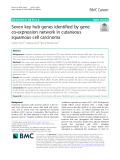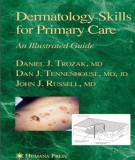
Actinic keratosis
-
Patients at risk of skin cancers can develop varying types of cutaneous malignancies. However, some subjects may develop only one type of lesion. In this cross-sectional study, the spectrum of premalignant (PM) and malignant skin lesions and their risk factors were studied.
 13p
13p  vikoch
vikoch
 27-06-2024
27-06-2024
 1
1
 1
1
 Download
Download
-
Cutaneous squamous cell carcinoma (cSCC) often follows actinic keratosis (AK) and is the second most common skin cancer worldwide. To reduce metastasis risk, it is important to diagnose and treat cSCC early. This study aimed to identify hub genes associated with cSCC and AK.
 12p
12p  vimahuateng
vimahuateng
 26-11-2021
26-11-2021
 16
16
 1
1
 Download
Download
-
: Inhibitors of mutant BRAF are emerging as standard of care in patients with metastatic melanoma who carry relevant oncogenic mutations. However, BRAF inhibitors are found to induce cutaneous squamous cell carcinoma (cuSCC). Population-based background rates of cuSCC and non-cutaneous squamous cell carcinoma (non-cuSCC) in the metastatic melanoma population may contextualize safety signals from randomized clinical trials or the clinics.
 11p
11p  vinaypyidaw2711
vinaypyidaw2711
 26-08-2020
26-08-2020
 9
9
 2
2
 Download
Download
-
(BQ) Continued part 1, part 2 of the document Dermatology skills for primary care - An illustrated guide presents the following contents: Pigmented, Pre-Malignant, and common malignant skin lesions; vesiculo - bullous and papulo pustular disorders.
 195p
195p  thangnamvoiva5
thangnamvoiva5
 14-07-2016
14-07-2016
 30
30
 2
2
 Download
Download
-
(BQ) Continued part 1, part 2 of the document Ferri's fast facts in dermatology presents the following contents: Diseases and disorders (acanthosis nigricans, acne keloidalis, acne vulgaris, actinic keratosis, alopecia areata, anagen effluvium, bacillary angiomatosis,...).
 394p
394p  thangnamvoiva5
thangnamvoiva5
 14-07-2016
14-07-2016
 44
44
 1
1
 Download
Download
-
To see the world as a web of information is a recent view. Humanity has contemplated the source and character of our knowledge since the dawn of time, but the present technologically oriented civilization demands a more concrete concept. Knowledge has been replaced by information. The information has to be carried by physical objects, and these are described by the theories of physics. Thus, we have to develop a theory for information coded in physical objects. Long ago, scientists developed formal descriptions of classical information transfer and its manipulation.
 249p
249p  hyperion75
hyperion75
 22-01-2013
22-01-2013
 53
53
 3
3
 Download
Download
-
The overall approach to learning medicine can be summed up in two questions: What is it? What do you do for it? The goal is to have a concise review that is readable and easy to follow with algorithms, diagrams, radiographs, and pathologic findings. This book is divided into subspecialty topics, each chapter written by an author(s) with clinical expertise in the designated topic. Images and tables are provided. Each chapter has bulleted items that highlight key points. These may be summary points from previous paragraphs or new points. Bulleted items also address typical clinical scenarios.
 930p
930p  hyperion75
hyperion75
 21-01-2013
21-01-2013
 46
46
 6
6
 Download
Download
-
Internal Medicine is designed to provide the busy clinician with precisely the information needed where and when it is needed. The Associate Editors and contributors are internationally recognized authorities, and they have organized the content specifically so as to convey the essentials necessary for diagnosis, differential diagnosis, management, treatment and follow-up. Many topics start with a “What To Do First” heading which brings the collective experience and guidance of top experts to bear on the “up front” considerations the clinician must face.
 1591p
1591p  hyperion75
hyperion75
 21-01-2013
21-01-2013
 51
51
 10
10
 Download
Download
-
Actinic keratosis, also known as solar keratosis, is a pre-cancerous skin condition caused by too much exposure to the sun. Actinic keratoses are usually small (less than 1/4 inch across), rough or scaly spots that may be pink-red or flesh-colored. Usually they develop on the face, ears, backs of the hands, and arms of middle-aged or older people with fair skin, although they can arise on other sun-exposed areas. People with one actinic keratosis usually develop many more. Actinic keratoses tend to grow slowly. They usually do not cause any symptoms.
 0p
0p  khongmuonnghe
khongmuonnghe
 07-01-2013
07-01-2013
 41
41
 1
1
 Download
Download
CHỦ ĐỀ BẠN MUỐN TÌM





















